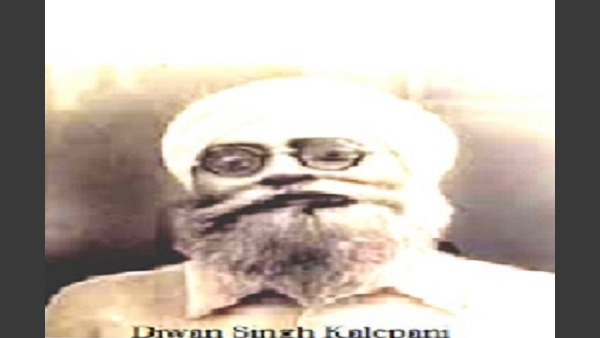
Azadi Ka Amrit Mahotsav: Diwan Singh Dhillon, unsung freedom fighter from the Andamans
New Delhi, Jun 18: As India celebrates its 75th Independence Day, the country will pay homage to the many men and women who sacrificed their lives and paved the way forward. Diwan Singh Dhillon alias Diwan Singh Kalepani is one such hero, who led the freedom struggle in the Andamans.
Diwan Singh, was born on 12 May 1897. His mother died when Diwan Singh Dhillon was two years old only. His father also died very soon. He grew up under the parental care of Sohan Singh, his father's younger brother.

Dr. Diwan Singh a doctor was recruited by the Indian Medical Department. He was a follower of Mahatma Gandhi during the Non-Cooperation Movement in 1920. Living in Lahore, he started wearing Khaddar and gave up the use of anything foreign. From Lahore, he was posted at Dagshai in Simla Hills. For the first time in 1921, Dr. Diwan Singh was arrested in Dagshai for delivering a speech in a public meeting against British rule. Nobody from the public came against him in the court. Eventually, Dr. Diwan Singh was released on lack of evidence.
In April 1927, on the disbandment of his regiment, Dr. Diwan Singh was posted from Rangoon to Port Blair in the Andaman Islands as a civil doctor. He took over the charges in Cellular Jail on 20 October 1927. In addition to his duties as a healer and reformer in the Andamans, he continued to follow the path of various movements of the freedom struggle being campaigned in mainland India by the nationalist leaders. He was once suspected by the officers and as a punishment, he was for two years transferred to Bamboo Flat, then a place with meager facilities.
Dr. Diwan Singh was a great poet. He wrote poems first in Urdu and Punjabi. 'Wagde Pani' is one of his famous poems. Being a prolific writer he continued to publish in Punjabi journals. A few of those publications were Phulwari, Mauji, Kavi, Amrit, Pritam, Prit lari, Panj Darya, Fateh, Likhari, Ranjit Nagara, and Navin Dunya. The only change of now was that soon after arrival in the Andamans, he took on the nom de plume of 'Kalepani' and suffixed to his name, thus becoming Dr. Diwan Singh Kalepani. In the literary circles in Punjab and to the Punjabi-reading people all over the country he came to be known as Diwan Singh Kalepani. During that time, the 'Andamans' was often known and addressed as 'Kalapani', and the word mirrored a hell-like place of inhuman torture.
On the 1 of August 1937, he laid the foundation stone of the New Gurudwara at Port Blair. To recognize the efforts and sacrifice made by Dr. Diwan Singh Kalepani for the sake of truth and righteousness, the New Gurudwara was renamed in his honor as 'Dr. Diwan Singh Gurudwara' by Notice No. 89 dated 06-12-1948 signed by Sardar Bakhtawar Singh, the Honorary Secretary. This august decision was taken by Sardar Mohan Singh Ji, the then Jathedar who was on a visit to the island.
The historic Dr. Diwan Singh Gurudwara is the only Gurudwara perhaps in the country, which has been named after a person other than the Sukh Gurus.
On 23 March 1942, the Japanese forces arrived in the Andamans. Dr. Diwan Singh continued his social services and became President of the Indian Independence League (IIL) in April 1942. The Japanese had to face the strong protest of Dr. Diwan Singh when they tried to vacate the New Gurudwara to accommodate the Korean comfort women. This time the protest was quite effective in favor of Dr. Diwan Singh. Dr. Diwan Singh fell under suspicion of the Japanese and he was arrested on 23-10-1943. By this time he became President of the Indian Independence League. In the jail, Dr. Diwan Singh had to bear almost all forms of torture.
Meanwhile, Netaji Subhash Chandra Bose arrived in the Andamans on 29 December 1943, hoisted the first Indian National Flag at Port Blair on the next day, and visited the Cellular Jail. During his entire visit to the Andamans, he was always surrounded and escorted by Japanese officials and soldiers. He was unaware of the imprisonment and torture inflicted on Dr. Diwan Singh, President of the IIL, and the other members of IIL and INA in the Wing No 6 of the Cellular Jail. Netaji was not left alone during his visit.
Dr. Diwan Singh and other prisoners had to continue to bear the series of torture and during a course of torture; Dr. Diwan Singh left this world in Wing No. 6 of the Cellular Jail without breaking his spirit on 14 January 1944. This great hero of the Andamans' freedom struggle truly deserves a dignified space in our lore.


 Click it and Unblock the Notifications
Click it and Unblock the Notifications


































